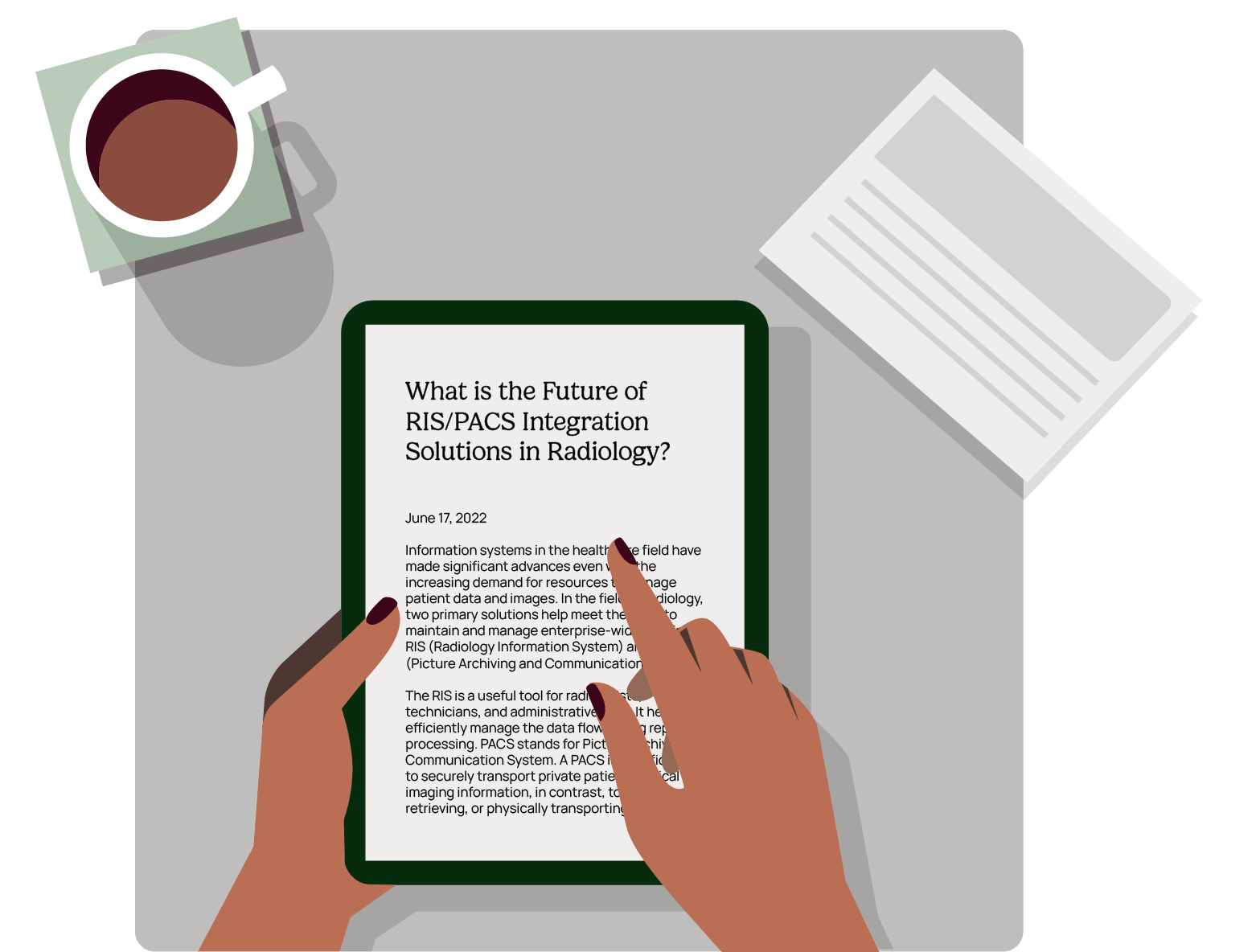May 13, 2022
Advancements in Radiology are occurring at a much faster rate than in the 20th century. Technological advancements are improving the way radiologists work, providing clearer images and interacting with machines that deliver results quickly and accurately.
Radiology is now an integral part of the entire medical field and with the use of Artificial Intelligence on the rise in various industries, healthcare organizations are trying to make the most out of it in radiology. As the demand for better images and the ability to manage images and analytics across the enterprise, grows, physicians are looking for new innovative solutions to meet these needs.
Advancements in Radiology are occurring at a much faster rate than in the 20th century. Technological advancements are improving the way radiologists work, providing clearer images and interacting with machines that deliver results quickly and accurately.
Radiology is now an integral part of the entire medical field and with the use of Artificial Intelligence on the rise in various industries, healthcare organizations are trying to make the most out of it in radiology. As the demand for better images and the ability to manage images and analytics across the enterprise, grows, physicians are looking for new innovative solutions to meet these needs.
The primary purpose of AI is for better decision-making to improve patient outcomes. Moreover, the growing population and shrinking human resources make it necessary to use technology to make the overall process of radiology more effective with fewer resources. Thus, there is an increasing demand for AI in radiology.
In this article, we look at the future of radiology and how the field could advance over the next few decades.
AI in Radiology
Before we dive into the future of AI in radiology, we need to look at how applied AI is changing healthcare. AI is not entirely new to the field of radiology – many departments in the healthcare field are already implementing and using it, including radiology.
The rise in the usage of AI in radiology is a clear indicator of the rapid changes we can expect in the years to come. As per the American College of Radiology, the clinical adoption of AI has seen a rapid increase. The usage of AI has grown to 30% in 2020, compared with virtually non-existent use in 2015.
Though there are some obstacles to implementing Artificial Intelligence in radiology, we can expect doctors and scientists to find ways to overcome them in the future and find ways to leverage the power of AI in radiology.
The first step in the widespread adoption of AI in radiology is to ensure radiologists and other caregivers have the proper understanding and training for it. Then, they will be able to leverage AI in radiology to its fullest.
Today, AI technology is being used in a variety of ways throughout the healthcare industry. As per Bibb Allen, MD, FACR, and CMO of the ACR’s Data Science Institute (DSI), Artificial Intelligence can be found in many items, including the;
- Auto-segmentation of various human body parts in 3D post-processing.
- Using computers and multiple technologies for detecting cancer.
- NLP (Natural language processing) to simplify paramount reporting results.
The Impact of Molecular Imaging and Genomics in Radiology
Molecular imaging and genomics are now becoming an integral part of radiology. Physicians can study patients at the cellular and molecular level inside the body using molecular imaging. It is possible to do so through different biological processes that molecular imaging allows. Using these techniques and processes, doctors can diagnose diseases earlier improving the care they provide.
Genomics is also a new field similar to molecular imaging in radiology. It includes the study of the body’s genes and how their functions and characteristics influence the overall effects, movement, and growth of the human body.
The primary function of genomics is to help doctors identify diseases at an early stage, enabling them to design a customized treatment for that particular disease.
Related: Radiology Solutions
How Does Molecular Imaging Help Physicians?
Molecular imaging is a critical tool for physicians, helping in numerous ways. For example:
- It helps to identify the scope or seriousness of any disease and its impact on the different parts of the body.
- It allows the option to choose the most effective therapy depending on the patients’ distinct biologic characteristics and the molecular effect of a particular disease.
- Physicians can determine how the patient’s body reacts to a particular medication.
- Physicians can incorporate the new medication and treatment procedures due to the changing cellular activity
- It can identify any changes or recurrence of the illness to prevent it from spreading further.
- It can evaluate how the disease progresses to develop a treatment plan accordingly.
The Impact of Interventional Radiology
There is a growing rise in the demand for interventional radiology procedures. However, it will require doctors and physicians in the field of radiology to undergo extensive training and seminars.
There is a special team of Advanced practice providers (APPs) who are trained in the field of interventional radiology, comprised of healthcare professionals who have the required expertise and training including:
- Advanced practice nurses
- Clinical nurse specialists
- Radiologist assistants
- Physician assistants
- Nurse practitioners
Interventional radiology entails using invasive medical treatments that doctors can do with the help of images, including X-rays and ultrasound, helping guide the doctor during a particular procedure.
Interventional radiology is seeing a rapid rise in its usage, and medical providers can often utilize it as a substitute for conventional surgeries. As a result, it can help the patients to get better treatments and reduce the time they have to stay in the hospital.
In addition, interventional radiology can be helpful in numerous ways for doctors and patients. It offers many procedures that can improve patient outcomes, such as:
- Drain organs that have the potential of causing a deadly infection.
- Remove blood clots that could result in a stroke.
- Prevent extreme and life-threatening bleeding due to various conditions, such as complications while giving birth, or trauma injuries.
The procedure is also helpful in cases of non-threatening or non-emergency issues and can help in:
- Clear a clogged artery or open up a narrow one.
- Cure painful uterine fibroids.
- Eradicating cancer tumors.
Role of Radiologists in the Development of AI Technology for Radiology
A key takeaway regarding the current implementation of AI in radiology is that it often lacks involvement from radiologists. They need to have a more decisive role in shaping the future of AI and radiology, rather than the data scientists and engineers who currently play a much more significant role in AI for healthcare.
Because these roles may not have a sound understanding of the issues associated with implementing AI in radiology, it is vital that radiologists are included in the planning and implementation of AI in radiology.
Dr. Mitch Schnall made the point that his organization has been utilizing the data for quite some time. However, the relevance of the information wanes after a few years due to the ever-changing therapeutic tools.
Therefore, professionals in the medical field can play a vital role in the advancements of medical technology and the utilization of AI in radiology.
What Can We Expect to See in Radiology in The Next 20 Years?
The future of AI is driven by technological advancements, as it has in years passed. If we look at radiology 20 years ago, we see how practitioners and radiologists used films for diagnosis and treatment.
With ever-changing technology, AI will be the driving force behind change in the medical landscape. It will open up numerous new avenues for not just radiologists but for many other professionals in healthcare.
Artificial intelligence will enable breakthroughs in patient care and radiologists have the opportunity to develop a variety of new skills to take advantage of these breakthroughs. It will streamline the process for radiologists, enabling them to make better-informed decisions for their patients.
In Summary
We can expect to see significant changes in the next 20 years in radiology. These advancements will come at a much faster pace than they did in the last 20 years due to the rapid evolution of technology, driven in large part by artificial intelligence, which has the potential to reshape the entire healthcare industry.
However, implementing AI will come with its set of pros and cons that professionals need to address. Additionally, the impact of interventional radiology and genomics is already reshaping the entire industry. We can also expect to see further advancements in healthcare, which will improve the performance of the healthcare provider and dramatically improve patient outcomes.
As a leading healthcare technology provider, the team at Intelerad is ready to help radiologists and other providers to take advantage of the benefits of AI. Request a demo with our experts for more information on these important trends.





